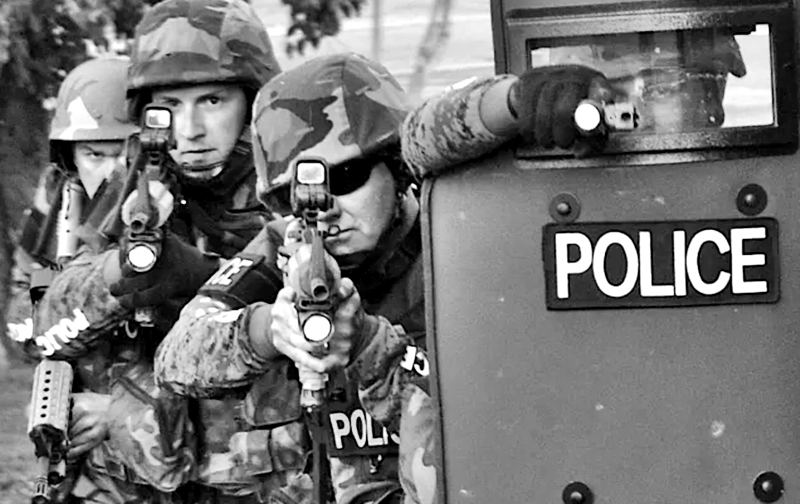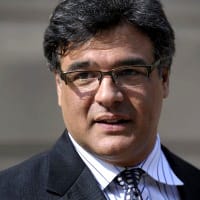Militarized Police

By John Kiriakou / Consortium News - October 11, 2025
With Zohran Mamdani poised to win the New York mayor’s race, the red herring of “defunding the police” is rearing its head again. I say “red herring” because almost nobody wants to actually defund police. That’s silly. But Republicans love being able to hit Democrats over the head with it.
Sen. John Kennedy (R-LA) said in a congressional hearing that, once police departments are “defunded,” Democrats can “call a crackhead” when somebody breaks into their houses. He made sure to repeat the phrase for a political ad.
The issue is that “Defund the Police,” which is probably inappropriately named, actually calls for transferring resources from the tactical focus of most police departments and transferring it to things like de-escalation training, i.e., training how to handle people who haven’t committed any obvious crime, but who are in the midst of a mental health crisis.
Remember, it was a decision by the Los Angeles Police Department in 1967 to create the country’s first SWAT (Special Weapons and Tactics, previously Special Weapons Attack Team) unit and begin dressing like G.I. Joe heading into combat. Many of us believe that that wasn’t necessarily a good thing.
Things only got worse from there. In 1989, as a provision of the National Defense Authorization Act, Congress allowed the U.S. Department of Defense to begin transferring surplus military hardware to local police departments.
The Atlantic Monthly put things in perspective just weeks after the start of the so-called Global War on Terror, when it wrote that this transfer from the Defense Department to local police departments included everything from combat-capable body armor to armored personnel vehicles to attack helicopters.
Serious think tanks like the Brookings Institution also have weighed in on the damage that these hyper-militarized police departments have done in local communities.
The bottom line, really, is, as one example, “Does Ohio State University really need a tank?” Incidentally, that’s not a question that I came up with. It’s a question posed by the school’s student newspaper in an article published when the Ohio State Police Department took delivery of a fully armored Mine Resistant Ambush Protected (MRAP) vehicle.
As the article’s author noted, the vehicle was “an incredibly overpowered and over-armored machine of war.” The university’s police chief agreed that that’s exactly what it was, and added that the university, “is frequently like a war zone, and it requires an equal, if not escalated, response.”
We’re talking about Ohio State University here, in the center of Columbus, Ohio. The university’s police chief is either deluded, lying, or an idiot.
This all begs the question, then, of why police departments don’t spend the money they’re wasting to maintain these vehicles and other unnecessary death machines on additional training, especially as it relates to mental health.
The Washington Post reported last year that between 2015 and 2024, 10,429 people were killed by police across the U.S. Fully one-fifth to one-quarter — as many as 2,625 Americans — were killed by police while in the midst of a mental health crisis.
How many of those people would have lived if the police had the training necessary to deescalate and deal with the situation? But then again, they wouldn’t have that cool body armor.
Prison Bureau Whistleblower
Last month I sat down with a whistleblower from the federal Bureau of Prisons (BOP), which also has been militarized over the past decade or two, to discuss how to turn things around.
Heidi Higgins, who spent 20 years in the BOP as a corrections officer, case manager, and correctional treatment specialist, said:
“I was a federal law enforcement officer for two decades as a senior case manager and correctional treatment specialist for the U.S. Department of Justice, at the Federal Bureau of Prisons, in the Metropolitan Detention Center located in the middle of downtown Los Angeles.
I have a B.A. in criminal justice from Gonzaga University (1998), and an M.A. in criminal justice from Washington State University (2001). My Master’s thesis was entitled: “Boot Camp Prisons: Panacea or Potential?”
I have witnessed every horror imaginable. They would make your worst nightmare look like Winnie The Pooh. I worked Thanksgivings, Christmases and in the middle of many nights helping to ensure that you and your loved ones could sit together at holidays and were protected from monsters who could make your blood curdle.
I read court transcripts about attacks on children as young as 4 months old, and the testimony of 10 years old girls in Thailand that had been trafficked by their own parents into the tourist sex trade there. Then I got off duty and came home to my own children and make the mental transition into Mommy Mode.
I sat with the highest level ranking members of some of the most notoriously violent gangs. Think MS13, Mexican Mafia, Aryan Brotherhood, Armenian Power and Black Guerilla Family. I had their respect and they had mine.
I dealt with slick sickos like Jeffrey Epstein and Bernie Madoff, and fraudsters who stole millions and millions of your tax dollars.
I helped men and women from foreign countries get in touch with their local embassies, so they could get any assistance they needed.
I was Whitey Bulger’s case manager when the F.B.I. captured him in Santa Monica after decades of being on the Top Ten Most Wanted list.
I ran to help fellow staff when inmates drunk on prison hooch beat them unconscious. And I drove the chase vehicle behind the ambulance and sat at that staff member’s hospital bedside for 14 hours taking meticulous notes to support criminal prosecutions for assaulting a federal officer, while simultaneously comforting the man’s wife.
I dealt with an entire unit of the criminally insane. I won’t say any more about that. Your imagination can’t possibly understand.
I turned a crooked staff member into Internal Affairs and watched her get walked out after the investigation revealed she was smuggling drugs into the facility.
I treated every inmate as a human being without ever sacrificing my character or integrity, and addressed their concerns within the scope of policy and ensured their every right was upheld.
I had to help cut the noose of a 23-year-old who hung himself in his cell’s light fixture. His name was Jesse, and he has a permanent place in my heart because it didn’t have to happen.
I was pregnant with all three of my children and worked right along the inmates who treated me with the upmost of respect because they knew I cared and they made sure that no nonsense came my way.
I witnessed prosecutorial overreach, and silently cheered when a genuinely innocent person won his appeal and was released.
I had to tell ‘gangbangers’ that their mother, brother, or child had died or had been killed. I sat with them through their grief and tears, and I made sure that they didn’t feel alone at that moment.
I unequivocally support the firing and/or prosecution of ‘crooks in uniform’ that only make our community and my fellow officers unsafe.”
Notice that there’s no rhetoric there; there are just lessons from 20 years at the tip of the spear with convicted, and in many cases, very dangerous individuals, many of whom suffer from mental illness.
The lesson isn’t to buy more advanced war machines, more advanced weapons, or more advanced body armor. The lesson is to treat people with respect, like human beings, rather than to intimidate them into submission.
The more important lesson is that when law enforcement officers are properly trained to deal with people in crisis, few die. And fewer end up in prison.
The time to transfer funding away from hardware and to counseling training is right now. It’s not too late. Maybe an outsider New York mayor can move the debate in the right direction.
Editor’s Note: At a moment when the once vaunted model of responsible journalism is overwhelmingly the play thing of self-serving billionaires and their corporate scribes, alternatives of integrity are desperately needed, and ScheerPost is one of them. Please support our independent journalism by contributing to our online donation platform, Network for Good, or send a check to our new PO Box. We can’t thank you enough, and promise to keep bringing you this kind of vital news.
In one of the scariest moments in modern history, we're doing our best at ScheerPost to pierce the fog of lies that conceal it but we need some help to pay our writers and staff. Please consider a tax-deductible donation.
You can also make a donation to our PayPal or subscribe to our Patreon.

John Kiriakou
John Kiriakou is a former CIA counterterrorism officer and a former senior investigator with the Senate Foreign Relations Committee. John became the sixth whistleblower indicted by the Obama administration under the Espionage Act—a law designed to punish spies. He served 23 months in prison as a result of his attempts to oppose the Bush administration’s torture program. Author Site
